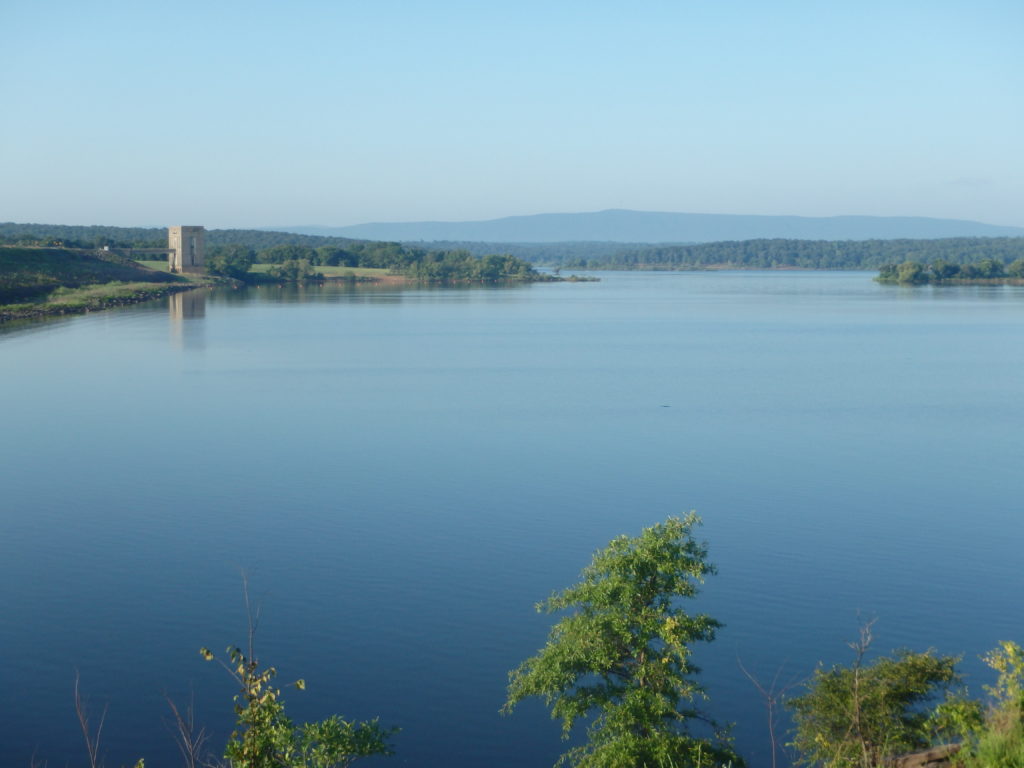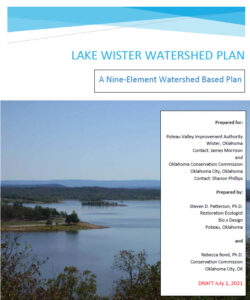Lake Wister is the source of water that PVIA treats and distributes. As such, both the quality of the water and the amount of water in the lake are of central concern to PVIA and its member agencies.
 The Lake Wister reservoir currently covers approximately 6,400 acres, with an average depth of eight feet.
The Lake Wister reservoir currently covers approximately 6,400 acres, with an average depth of eight feet.
- Lake Wister was created in 1949 by the closing of Wister Dam.
- PVIA has been using water from Wister to supply to the Poteau Valley region since 1969.
Lake Wister has proven itself over the years to be a reliable source of drinking water for LeFlore County and the greater region. However, water quality has suffered from excessive loads of nutrients (that is, fertilizers, particularly phosphorus) and sediments entering the lake. Nutrients cause more algae to grow, which in turn leads to increased expense in treating the water, to low dissolved oxygen levels in the summer (bad for fish and other aquatic life, as well as water treatment), and other problems. The growth of certain types of algae (blue-green, also known as cyanobacteria) can cause drinking water to taste or smell bad at certain times of the year.
Sediment entering the lake contributes to turbidity (cloudiness) of the water and gradually sediment will fill in the lake.
Current Projects:
In recent years, PVIA has lead several efforts to protect and improve water quality at Lake Wister. Current projects include:
Lake Wister Watershed Based Plan
 PVIA sponsored, in collaboration with the Oklahoma Conservation Commission, the development of a watershed plan for the Lake Wister watershed. Steve Patterson of Bio x Design and the Oklahoma Conservation Commission co-authored the plan. The purpose of the plan is to outline methods to reduce the amount of nutrients (that is, fertilizers, especially phosphorus) and sediments that enter Lake Wister.
PVIA sponsored, in collaboration with the Oklahoma Conservation Commission, the development of a watershed plan for the Lake Wister watershed. Steve Patterson of Bio x Design and the Oklahoma Conservation Commission co-authored the plan. The purpose of the plan is to outline methods to reduce the amount of nutrients (that is, fertilizers, especially phosphorus) and sediments that enter Lake Wister.
- After review by the Oklahoma Conservation Commission and the US EPA, the watershed plan has been submitted for final approval. You can read or download (PDF) a copy of the plan here.
Lake Wister Water Quality Modeling in Support of TMDL Development
PVIA began development of a computer model of Lake Wister in 2014, contracting with Dr. Thad Scott, a limnologist (lake specialist) then at the University of Arkansas to lead that effort. Dr. Steve Patterson at Bio x Design worked with Dr. Scott as PVIA’s ecological restoration consultant. Dr. Scott moved to Baylor University in 2016, where the modeling work was completed.
 The modeling report has been reviewed by PVIA and by the Oklahoma Department of Environmental Quality, and revised in response to their comments.
The modeling report has been reviewed by PVIA and by the Oklahoma Department of Environmental Quality, and revised in response to their comments.
- A copy of the Lake Wister Water Quality Modeling in Support of Nutrient and Sediment TMDL Development report may be reviewed or downloaded here.
Earlier lake and watershed work
Previous project include:
Restoring Lake Wister: PVIA’s Strategic Plan to Improve Water Quality and Lake Ecosystems
- You can read or download this report here.
Best Management Practices for Construction and Maintenance of Dirt and Gravel Roads, on February 28, 2013, at Lake Wister.
Reducing soil erosion from unpaved roads in the watershed. One of the main sources of soil erosion in many watersheds is sediment that enters streams and eventually the lake from eroding dirt and gravel roads. PVIA partnered with the Choctaw Nation and the Nature Conservancy to sponsor a workshop highlighting techniques of road construction and maintenance that can help reduce erosion, while saving money in the long run because the need for road maintenance is reduced.
For more information on the workshop and these techniques, click here.
